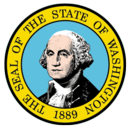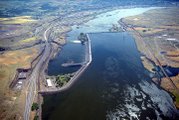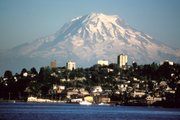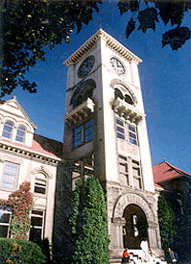
Washington State Flag |

Washington State Seal |

Washington Location |
Washington
Washington
is a state in the Pacific Northwest of the United
States. The state capital is Olympia
and the largest city in Washington
is Seattle.
As of the 2000 census, the state population was approximately 5.9 million
and the state work force numbered about 3.1 million. Residents are called
"Washingtonians" (emphasis on the third syllable, which rhymes
with bone).
It should not be
confused with Washington, D.C.,
the nation's capital. To avoid confusion, the capital is often called
simply D.C. and the state
often called Washington state.
Washington
is the only state named after a president, who was George Washington.
The battleship USS
Washington was named originally for President Washington, but was later
renamed in honor of the state.
| Capital |
Olympia |
|
| Largest
City |
Seattle |
| Governor
(2005) |
Christine
Gregoire (D) |
Area
- Total
- Land
- Water
- % water |
184,824 km² (18th)
172,587 km²
12,237 km²
6.6% |
Population
- Total (2000)
- Density |
5,894,121 (15th)
34.20 /km² (25th) |
Admittance
into Union
- Date
- Order |
November 11, 1889
42nd |
| Time
zone |
Pacific:
UTC-8/-7 |
Latitude
Longitude |
45°32'
N to 49° N
116°57' W to 124°48' W |
Width
Length
Elevation
- Highest
- Mean
- Lowest |
385
km
580 km
4,392 m
520 m
0 m |
| ISO
3166-2 |
US-WA
|
| State
nickname |
The
Evergreen State |
| Official
Languages |
None |
|
|
Geography
  Washington
is bounded by the Pacific Ocean to the west, Oregon
to the south (the Columbia River forming most of this border), Idaho
to the east and British Columbia,
Canada to the north. It is famous for scenery of breathtaking beauty
and sharp contrasts. High mountains rise above evergreen forests and
sparkling coastal waters. Its coastal location and Puget Sound harbors
give it a leading role in trade with Alaska,
Canada, and the Pacific
Rim. Puget Sound's many islands are served by the largest ferry fleet
in the United States. Washington
is bounded by the Pacific Ocean to the west, Oregon
to the south (the Columbia River forming most of this border), Idaho
to the east and British Columbia,
Canada to the north. It is famous for scenery of breathtaking beauty
and sharp contrasts. High mountains rise above evergreen forests and
sparkling coastal waters. Its coastal location and Puget Sound harbors
give it a leading role in trade with Alaska,
Canada, and the Pacific
Rim. Puget Sound's many islands are served by the largest ferry fleet
in the United States.
Washington
is a land of contrasts. The deep forests of the Olympic Peninsula are
among the rainiest places in the world and the only rainforests (such
as the Hoh Rain Forest) in the continental United
States, but the flat semi-desert that lies east of the Cascade Range
stretches for long distances without a single tree. Snow-covered peaks
tower above the foothills and lowlands around them. Mount Rainier, the
highest mountain in the state, appears to "float" on the horizon
southeast of Seattle
and Tacoma on
clear days. The eastern side of the state can be divided into two regions:
the Okanogan Highlands and the Columbia River Basin.
Washington
is also notable for being home to four of the five longest floating
bridges in the world: the Evergreen Point Floating Bridge, Lacey V.
Murrow Memorial Bridge and Homer M. Hadley Bridge over Lake Washington,
and the Hood Canal Bridge connecting the Olympic and Kitsap Peninsulas.
History
Prior to the arrival
of explorers from Europe, this region of the Pacific Coast had many
established tribes of Native Americans, each with its own unique culture.
Today, they are most notable for their totem poles and their ornately
carved canoes and masks. Prominent among their industries were salmon
fishing and whale hunting. In the east, nomadic tribes travelled the
land and missionaries such as the Whitmans settled there.
The first European
record of a landing on the Washington
coast was by Spanish Captain Don Bruno de Heceta in 1775 on board the
Santiago, part of a two-ship flotilla with the Sonora. They claimed
all the coastal lands up to the Russian possessions in the north for
Spain.
In 1778, British
explorer Captain James Cook sighted Cape Flattery, at the entrance to
the Strait of Juan de Fuca, but the straits would not be explored until
1789 by Captain Charles W. Barkley. Further explorations of the straits
were performed by Spanish explorers Manuel Quimper in 1790 and Francisco
Eliza in 1791, then by British Captain George Vancouver in 1792.
The Spanish Nootka
Concession of 1790 opened the northwest territory to explorers and trappers
from other nations, most notably Britain and then the United
States. Captain Robert Gray (for whom Grays Harbor county is named)
then discovered the mouth of the Columbia river and, beginning in 1792,
he established trade in Sea Otter pelts. In 1805 the Lewis and Clark
expedition entered the state on October 10.
In 1819 Spain ceded
their original claims to this territory to the United
States. This began a period of disputed joint-occupancy by Britain
and the U.S. that lasted until
June 15, 1846 when Britain ceded their claims to this land with the
Treaty of Oregon.
Due to the migration
along the Oregon Trail, many settlers wandered north to what is now
Washington and settled the
Puget Sound area. The first settlement was New Market (now known as
Tumwater)
in 1846. In 1853 the Northern Pacific railroad line reached Puget Sound,
linking the region to the other states. During that same year Washington
Territory was formed from part of Oregon
Territory.
Washington
became the 42nd state in the United
States on November 11, 1889.
Early prominent
industries in the state included agriculture and lumber. In eastern
Washington the Yakima Valley became known for its apple orchards while
the growth of wheat using dry-farming techniques became particularly
productive. The heavy rainfall to the west of the Cascade Range produced
dense forests and the ports along Puget Sound prospered from the manufacturing
and shipping of lumber products, particularly the Douglas fir. Other
industries that developed in the state include fishing, salmon canning
and mining.
By the turn of the
20th century the state of Washington
was one of dangerous repute in the minds of many Americans. Undisputably
as "wild" as the rest of the wild west, the public image of
Washington merely replaced
cowboys with lumberjacks, and desert with forestland. One city in particular,
Aberdeen,
had the distinction of being "the roughest town west of the Mississippi"
due to excessive gambling, violence, extreme drug use and prostitution
(the city itself changed very little over the years and remained off-limits
to military personnel well into the early 1980's).
For a long period
Tacoma was noted
for its large smelters where gold, silver, copper and lead ores were
treated. Seattle
was the primary port for trade with Alaska
and the rest of the country and for a time possessed a large ship-building
industry. The region around eastern Puget Sound developed heavy industry
during the period including World War I and World War II and the Boeing
company became an established icon in the area.
During the depression
era a series of hydroelectric dams were constructed along the Columbia
river as part of a project to increase the production of electricity.
This culminated in 1941 with the completion of the Grand Coulee Dam,
the largest in the United States.
During World War
II the Puget Sound area became a focus for war industries with the Boeing
Company producing many of the nation's heavy bombers and ports in Seattle,
Bremerton,
and Tacoma available
for the manufacturing of ships for the war effort. In eastern Washington
the Hanford Works atomic energy plant was opened in 1943 and played
a major role in the construction of the nation's atomic bombs.
In 1980, following
a period of heavy tremors and eruptions, the northeast face of Mount
St. Helens exploded outward, destroying a large part of the top of the
volcano. This eruption flattened the forests for many kilometers, killed
57 people, flooded the Columbia River and its tributaries with ash and
mud and blanketed large parts of Washington
in ash, making day look like night.
Law and Government
Washington
has usually been considered a key swing state politically, although
in recent elections, it has been comfortably in the hands of the Democrats.
The state is literally
split down the middle politically, with Eastern Washington firmly in
the hands of the Republican Party and Western Washington, especially
around Seattle,
firmly in Democratic hands. Since the population is larger in the west,
the Democrats usually fare better statewide.
Although nationally,
Washington is not usually
a major force in politics, in 1994, Washington
was one of the places where the Republican Party gained power in their
nationwide landslide. Republicans won six of the eight House of Representative
seats held by Democrats and Republican Slade Gorton held on to his Senate
seat.
Washington
has voted for the Democratic candidate in presidential elections recently
in 1988, 1992, 1996, 2000 and 2004. It was considered a key swing state
in 1968 and 2000. In 1968, it was the only Western state to give its
electoral votes to Hubert Humphrey. In 2004, John Kerry won the state's
11 electoral votes by a margin of seven percentage points with 52.8%
of the vote.
In 2004, Washington's
gubernatorial race was so close that the Secretary of State certified
Republican candidate Dino Rossi as governor-elect almost a month after
the polls had closed, beating out the Democratic candidate Christine
Gregoire by just over two hundred votes. Due to the small margin of
victory, a machine recount (required by law) took place and, by a margin
of only 42 votes out of more than 2.8 million cast, Rossi won again.
However, the Democrats requested a final hand count of the votes. Gregoire
ended up winning this count by 129 votes and was inaugurated on January
12, 2005. The subsequent court battles raged for months after the election,
but ultimately ended with Gregoire retaining her office. The final official
count left Gregoire ahead by 133 votes.
Washington
has the distinction for being the first and so far only state to elect
women to all three major statewide offices at the same time, both Senators
and the Governor.
Transportation
Amtrak Cascades
Interstate 5
Interstate 82
Interstate 90
Interstate 205
Interstate 405
U.S. Highway 2
U.S. Highway 12
U.S. Highway 97
U.S. Highway 101
Washington has an extensive
system of state highways, called State Routes and the third largest
ferry system in the world.
Demographics
|
According to the U.S. Census Bureau, as of 2004, Washington's
population was 6,203,788. This includes 631,500 foreign-born (10.3%
of the state population), and an estimated 100,000 illegal aliens
(1.6% of state population).
Race and Ancestry
The racial
makeup of the state:
78.9% White
3.2% Black
7.5% Hispanic
5.5% Asian
1.6% Native American
3.6% Mixed race
The five
largest reported ancestries in Washington
are: German (18.7%), English (12%), Irish (11.4%), Norwegian (6.2%)
and Mexican (5.6%).
Many Mexicans
are migrant farm workers, living in the southeast-central part
of the state. Wahkiakum County has many residents of Scandinavian
origin. Washington
has the fifth largest Asian population of any state, with Filipinos
being the largest group.
6.7% of Washington's
population were reported as under 5, 25.7% under 18, and 11.2%
were 65 or older. Females made up approximately 50.2% of the population.
Religion
The religious
affiliations of Washington's population are:
Christian
– 71%
Protestant – 45%
Baptist – 7%
Lutheran – 7%
Methodist – 4%
Presbyterian – 3%
Other Protestant or general Protestant – 24%
Roman Catholic – 22%
Mormon – 5%
Other Christian – 1%
Other Religions – 2%
Non-Religious – 27%
As with many
other western states, the percentage of Washington's population
identifying themselves as "non-religious" (an umbrella
term which is sometimes synonymous with or includes elements of
atheism, agnosticism, skepticism, freethought, humanism, secular
humanism, heresy, logical positivism, and even apathy) is much
higher than the rest of the U.S. The percentage of non-religious
people in Washington
is the highest of any state, and church membership is among the
lowest of all states. |
| Historical
populations |
Census
year |
Population
|
1850 |
1,201 |
1860 |
11,594
|
1870 |
23,955
|
1880 |
75,116
|
1890 |
357,232
|
1900 |
518,103
|
1910 |
1,141,990
|
1920 |
1,356,621 |
1930 |
1,563,396
|
1940 |
1,736,191 |
1950 |
2,378,963
|
1960 |
2,853,214
|
1970 |
3,409,169
|
1980 |
4,132,156
|
1990 |
4,866,692
|
2000 |
5,894,121
|
|
Economy
 The
2003 total gross state product for Washington
was $244 billion, placing it 11th in the nation. The per capita income
was $33,332. Significant business within the state include the design
and manufacture of jet aircraft (Boeing), computer software development
(Microsoft, Amazon.com, Nintendo of America), electronics, biotechnology,
aluminum production, lumber and wood products, mining, and tourism.
The state has significant amounts of hydroelectric power generation.
Significant amounts of trade with Asia pass through the ports of the
Puget Sound. The
2003 total gross state product for Washington
was $244 billion, placing it 11th in the nation. The per capita income
was $33,332. Significant business within the state include the design
and manufacture of jet aircraft (Boeing), computer software development
(Microsoft, Amazon.com, Nintendo of America), electronics, biotechnology,
aluminum production, lumber and wood products, mining, and tourism.
The state has significant amounts of hydroelectric power generation.
Significant amounts of trade with Asia pass through the ports of the
Puget Sound.
Agriculture
 Washington
is a leading agricultural state. (The following figures are from the
Washington State Office of Financial Management and the Washington Agricultural
Statistics Service.) Washington
is a leading agricultural state. (The following figures are from the
Washington State Office of Financial Management and the Washington Agricultural
Statistics Service.)
For 2001, the total
value of Washington's agricultural products was $5.4 billion, the 12th
highest in the country. The total value of its crops was $3.2 billion,
the 8th highest.
In 2002 Washington
ranked first in the nation in production of raspberries (87.8% of total
U.S. production), hops (74.4%), spearmint oil (also 74.4%), wrinkled
seed peas (65.6%), apples (60.2%), Concord grapes (51.8%), sweet cherries
(48%), pears (44.9%), lentils (41.9%), peppermint oil (35.2%), carrots
for processing (34.5%), tart cherries (32.8%), Niagara grapes (32.4%)
and sweet corn for processing (29.2%). Washington
also ranked second in the nation in grapes (all varieties taken together),
apricots, asparagus (over a third of the country's production) and green
peas for processing; third in the nation for wheat, prunes and plums,
summer dry onions, trout and butter; fourth in barley and peaches; and
fifth in cranberries and strawberries.
 Important
Cities and Towns Important
Cities and Towns
Education
Colleges and Universities
| State
universities |
|
|
Central Washington University
Eastern Washington University
The Evergreen State College
University of Washington
Washington State University
Western Washington University
|
 |
|
| Private
universities |
|
|
Antioch University Seattle
Argosy University/Seattle
Art Institute of Seattle
Bastyr University
City University
Cornish College of the Arts
DeVry University
Gonzaga University
Henry Cogswell College
Heritage College
Northwest University
|
Pacific Lutheran
University
St. Martin's College
School of Visual Concepts
Seattle Bible College
Seattle Pacific University
Seattle University
Trinity Lutheran College
University of Puget Sound
Walla Walla College
Whitman College
Whitworth College |
|
| Community
colleges |
|
Bates Technical
College
Bellevue Community College
Bellingham Technical College
Big Bend Community College
Cascadia Community College
Centralia College
Clark College
Clover Park Technical College
Columbia Basin College
Edmonds Community College
Everett Community College
Grays Harbor College
Green River Community College
Highline Community College
Lake Washington Technical College
Lower Columbia College
|
Olympic College
Peninsula College
Pierce College
Renton Technical College
Seattle Community College District
Shoreline Community College
Skagit Valley College
South Puget Sound Community College
Spokane Community College
Spokane Falls Community College
Tacoma Community College
Walla Walla Community College
Wenatchee Valley College
Whatcom Community College
Yakima Valley Community College |

Professional Sports Teams
- Seattle Seahawks
Football, National Football League
- Seattle Sonics
Basketball, National Basketball Association
- Seattle Storm
Basketball, Women's National Basketball Association
- Seattle Mariners
Baseball, Major League Baseball; AL
- Seattle Sounders
Soccer, USL First Division (men's), W-League (women's)
- Seattle Thunderbirds
Ice Hockey, Western Hockey League
- Spokane Chiefs
Ice Hockey, Western Hockey League
- Everett Silvertips
Ice Hockey, Western Hockey League
- Tri-City Americans
Ice Hockey, Western Hockey League
- Tacoma Rainiers
Baseball, Pacific Coast League; AAA
- Spokane Indians
Baseball, Northwest League; A
- Everett AquaSox
Baseball, Northwest League; A
- Yakima Bears
Baseball, Northwest League; A
- Tri-City Dust
Devils Baseball, Northwest League; A
State designations and symbols
Official state symbols
of the U.S. state of Washington:
State motto: Al-ki
or Alki ("bye and bye")
State song: "Washington, My Home", adopted 1959
State flower: Coast Rhododendron, adopted 1892
State bird: American Goldfinch (Carduelis tristis), adopted 1951
State tree: Western hemlock, adopted 1947
State fish: Steelhead trout, adopted 1969
State insect: Green darner dragonfly, adopted 1997
State gem: Petrified wood, adopted 1975
State fruit: Apple, adopted 1989
State grass: Bluebunch wheatgrass, adopted 1989
State tartan: one designed by Margaret McLeod van Nus and Frank Cannonita,
adopted 1991
State fossil: Columbian mammoth, adopted 1998
State folk song: "Roll On, Columbia, Roll On," adopted 1987
State ship: the container ship President Washington, adopted 1983
State dance: Square dance, adopted 1979
Marine
Mammal
Washington's newest state symbol is the orca. In a effort led by second
and third grade students from Crescent Harbor Elementary in Oak
Harbor. Pods of orca are resident in Puget Sound and the surrounding
waters of the Pacific Ocean. Orca and other whale watching tourism brings
in millions of dollars of revenue to the state. It is a culturally significant
symbol for local tribes of Native Americans. Designation of the orca
as the state marine mammal is also an attempt to raise awareness in
protecting it's habitat.
The
above article in gray is licensed under the
It
uses material from the
|








 The
2003 total gross state product for
The
2003 total gross state product for 
 Important
Cities and Towns
Important
Cities and Towns

